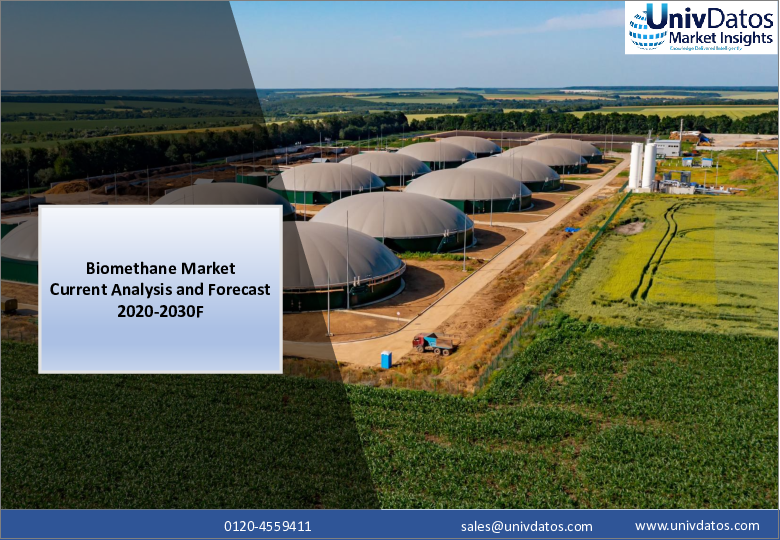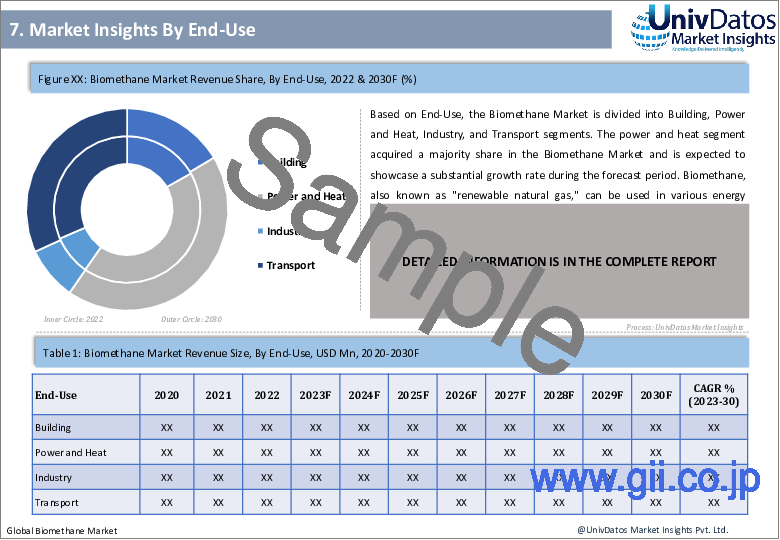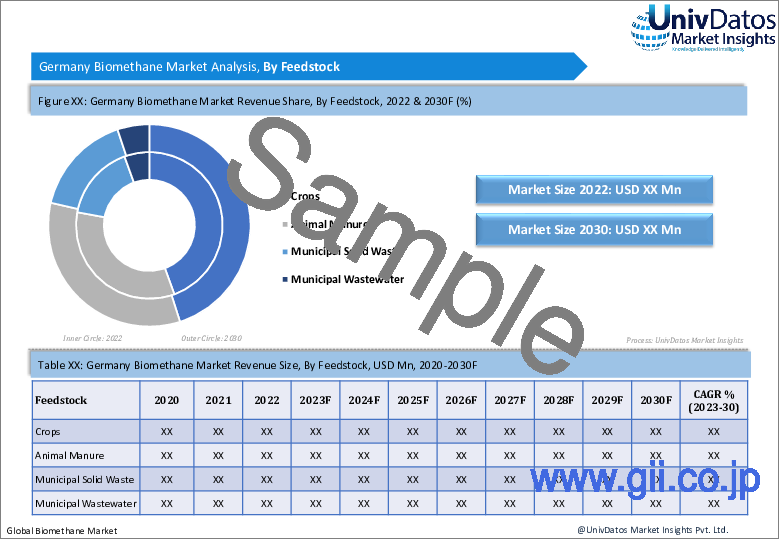|
|
市場調査レポート
商品コード
1408717
バイオメタン市場:現状分析と予測(2023-2030年)BIomethane Market: Current Analysis and Forecast (2023-2030) |
||||||
カスタマイズ可能
|
|||||||
| バイオメタン市場:現状分析と予測(2023-2030年) |
|
出版日: 2023年12月30日
発行: UnivDatos Market Insights Pvt Ltd
ページ情報: 英文 158 Pages
納期: 即日から翌営業日
|
- 全表示
- 概要
- 目次
バイオメタン市場は予測期間中、CAGR 4.4%の力強い成長が見込まれています。バイオメタンは、メタンが二酸化炭素の25倍も効果的に熱を大気中に閉じ込めるため、地球温暖化への影響が少なく、気候に優しい燃料です。また、各国のクリーンエネルギー目標に貢献し、ガス供給の多様化にも役立つため、化石燃料への依存度を下げることができます。
バイオメタン産業は現在のところ非常に小規模であるが、特に既存のインフラを利用して幅広いエンドユーザーにクリーンエネルギーを供給できる可能性があるため、いくつかの国で関心が高まっています。現在、バイオメタンは天然ガス需要の約0.1%を占めています。しかし、天然ガス・ネットワークの供給と輸送の脱炭素化を支援する政府の施策は増加しています。
原料に基づくと、バイオメタン市場は作物、家畜糞尿、都市固形廃棄物、都市廃水の各セグメントに分けられます。畜糞セグメントはバイオメタン市場の大半を占めており、予測期間中に大幅な成長率を示すと予想されています。嫌気性消化槽は糞尿処理のためのシステムであり、糞尿処理ではないです。牛糞は水分や繊維質が多く、バイオガスの収量や分解効率が低いため、農業におけるバイオガス技術の利用拡大を妨げています。バイオガスをバイオメタンにアップグレードすることで、バイオガスに含まれるCO2やその他の汚染物質を除去することができます。バイオメタンは、牛、豚、鶏、羊などの家畜の糞尿を含む様々な原料から生産することができます。バイオガスからのバイオメタンの生産は、さらなる成長の可能性を秘めた成長分野であるが、これは世界各地のガス供給の脱炭素化を目指した政策の強度と設計に大きく左右されます。
バイオメタン市場は、最終用途に基づき、建築、電力・熱、産業、輸送の各セグメントに分けられます。電力・熱セグメントはバイオメタン市場において大半のシェアを獲得しており、予測期間中に大幅な成長率を示すと予想されています。バイオメタンは「再生可能天然ガス」としても知られ、電力や熱を含む様々なエネルギー分野で利用することができます。2018年には、世界で生産されたバイオガスの大半が電力と熱の生産に使用されました。バイオメタン生産の収益性は、プラントの規模、基質投入量、グリッド接続コストに依存します。バイオガスは、電気と熱の生産に直接使用することができ、電気のみの施設とコージェネレーション施設はほぼ同じ割合です。
バイオメタン産業の市場導入をよりよく理解するために、市場は北米・南米(米国、その他北米・南米地域)、欧州(ドイツ、フランス、デンマーク、英国、その他欧州地域)、アジア太平洋(中国、日本、インド、その他アジア太平洋地域)、その他の地域における世界的存在に基づいて分析されます。欧州はバイオメタン市場において最も高い市場シェアを獲得しており、予測期間において影響力のあるCAGRを示すことが期待されています。欧州は現在、バイオガスの最大の生産国です。ドイツが圧倒的に大きな市場であり、欧州のバイオガスプラント容量の3分の1を占めています。エネルギー作物は、ドイツのバイオガス産業の成長を支える主要な供給原料の選択であったが、最近では、作物残渣、連作作物、家畜排泄物、埋立地からのメタン回収の利用へと政策がシフトしています。デンマーク、フランス、イタリア、オランダなどその他の国々も、バイオガス生産を積極的に推進しています。主要なバイオガス生産地域である欧州には、約2万基のバイオガスプラントがあり、その大半はドイツにあります。そのほとんどが自家発電と共同発電のために建設されており、バイオガスの改良に特化したプラントは約500カ所あります。さらに、欧州のいくつかの国々は、ガスを利用した輸送インフラも開発しています。スウェーデンのバイオメタン生産の大部分は自動車に使用されており、輸送需要におけるバイオメタン使用のシェアが最も高いです。イタリアでは、天然ガス自動車が整備され、燃料供給ネットワークが拡大しており、最近バイオメタンの混合義務を導入しました。
目次
第1章 市場イントロダクション
- 市場の定義
- 主な目標
- ステークホルダー
- 制限事項
第2章 調査手法または前提条件
- 調査プロセス
- 調査手法
- 回答者プロファイル
第3章 市場要約
第4章 エグゼクティブサマリー
第5章 世界のバイオメタン市場収益、2020-2030年
第6章 原料別の市場洞察
- 作物
- 動物の糞尿
- 都市固形廃棄物
- 都市下水
第7章 最終用途別の市場洞察
- 建物
- 電力と熱
- 業界
- 輸送
第8章 地域別の市場洞察
- 北アメリカと南米
- 米国
- 北米および南米のその他の地域
- 欧州
- ドイツ
- 英国
- フランス
- デンマーク
- その他欧州地域
- アジア太平洋
- 中国
- 日本
- インド
- その他APAC
- 世界のその他の地域
第9章 バイオメタン市場力学
- 市場促進要因
- 市場の課題
- 影響分析
第10章 バイオメタン市場機会
第11章 バイオメタン市場動向
第12章 需要側と供給側の分析
- 需要側分析
- 供給側分析
第13章 バリューチェーン分析
第14章 政府の政策と規制
第15章 競合シナリオ
- ポーターのファイブフォース分析
第16章 企業プロファイル
- Veolia Group
- Air Liquide
- Shell plc
- Landwarme GmbH
- BP p.l.c.
- SGN
- Biokraft International AB
- VERBIO
- Gasum Oy
- Greenlane Biogas
第17章 免責事項
Biomethane (also known as "renewable natural gas") is the "upgrading" of biogas (a process that removes CO2 and other pollutants present in biogas), or the subsequent gasification of solid biomass. It is a nearly pure methane source produced by methanation. The LHV of biomethane is approximately 36 MJ/m3. Because it is indistinguishable from natural gas, it can be used without requiring changes to transmission and distribution infrastructure or end-use equipment, and is fully compatible with use in natural gas vehicles.
The Biomethane Market is expected to grow at a strong CAGR of 4.4% during the forecast. Biomethane is a climate-friendly fuel because it has a low influence on global warming, as methane traps heat in the atmosphere 25 times more effectively than carbon dioxide. It also contributes to various countries clean energy objectives and helps diversify their gas supplies, reducing dependency on fossil fuels
Although the biomethane industry is currently very small-scale, there is growing interest in several countries, particularly because of its potential to use existing infrastructure to supply clean energy to a wide range of end users. Currently, biomethane accounts for approximately 0.1% of natural gas demand. However, there is a growing number of government measures to support the decarbonization of natural gas network supply and transportation.
Based on Feedstock, the Biomethane Market is divided into Crops, Animal Manure, Municipal Solid Waste, and Municipal Wastewater segments. The Animal Manure segment acquired a majority share in the Biomethane Market and is expected to showcase a substantial growth rate during the forecast period. An anaerobic digester is a system for manure treatment, not manure disposal. Cattle manure has high water and fiber contents, resulting in low biogas yields and degradation efficiency, which hamper an increased use of the biogas technology in agriculture. Upgrading biogas to biomethane can remove any CO2 and other contaminants present in the biogas. Biomethane can be produced from a wide variety of feedstocks, including animal manure from livestock including cattle, pigs, poultry, and sheep. The production of biomethane from biogas is a growing area with significant potential for further growth, although this is heavily contingent on the strength and design of policies aimed at decarbonizing gas supply in different parts of the world.
Based on End-Use, the Biomethane Market is divided into Building, Power and Heat, Industry, and Transport segments. The power and heat segment acquired a majority share in the Biomethane Market and is expected to showcase a substantial growth rate during the forecast period. Biomethane, also known as "renewable natural gas," can be used in various energy sectors, including power and heat. The majority of the biogas produced in the world was used for the production of power and heat in 2018. The profitability of biomethane production depends on plant size, substrate input, and grid connection costs. Biogas can be used directly to produce electricity and heat, with an approximately equal split between electricity-only facilities and co-generation facilities.
For a better understanding of the market adoption of the Biomethane industry, the market is analyzed based on its worldwide presence in countries such as North & South America (U.S.A., Rest of North & South America), Europe (Germany, France, Denmark, United Kingdom, and Rest of Europe), Asia-Pacific (China, Japan, India, and Rest of Asia-Pacific), Rest of World. Europe acquired the highest market share in the Biomethane Market and is expected to witness an influential CAGR in the forecasted period. Europe is the largest producer of biogas today. Germany is by far the largest market, and home to a third of Europe's biogas plant capacity. Energy crops were the primary choice of feedstock that underpinned the growth of Germany's biogas industry, but policy has recently shifted more towards the use of crop residues, sequential crops, livestock waste and the capture of methane from landfill sites. Other countries such as Denmark, France, Italy and the Netherlands have actively promoted biogas production. As the leading biogas-producing region, Europe has around 20,000 biogas plants, with the majority situated in Germany. Most are built for on-site electricity generation and co generation, with around 500 plants dedicated to the upgrading of biogas. Furthermore, Several countries in Europe are also developing gas-based transport infrastructure; most of Sweden's biomethane production is used in vehicles, giving it the highest share of biomethane use in transport demand. Italy has a well-established natural gas vehicle fleet and an expanding fuelling network, and has recently introduced biomethane blending obligations.
Some of the major players operating in the market include: Veolia Group, Air Liquide, Shell plc, Landwarme GmbH, BP p.l.c., SGN, Biokraft International AB, VERBIO, Gasum Oy, and Greenlane Biogas.
TABLE OF CONTENTS
1 MARKET INTRODUCTION
- 1.1. Market Definitions
- 1.2. Main Objective
- 1.3. Stakeholders
- 1.4. Limitation
2 RESEARCH METHODOLOGY OR ASSUMPTION
- 2.1. Research Process of the Biomethane Market
- 2.2. Research Methodology of the Biomethane Market
- 2.3. Respondent Profile
3 MARKET SYNOPSIS
4 EXECUTIVE SUMMARY
5 GLOBAL BIOMETHANE MARKET REVENUE, 2020-2030F
6 MARKET INSIGHTS BY FEEDSTOCK
- 6.1. Crops
- 6.2. Animal Manure
- 6.3. Municipal Solid Waste
- 6.4. Municipal Wastewater
7 MARKET INSIGHTS BY END-USE
- 7.1. Building
- 7.2. Power and Heat
- 7.3. Industry
- 7.4. Transport
8 MARKET INSIGHTS BY REGION
- 8.1. North & South America
- 8.1.1. United States
- 8.1.2. Rest of North & South America
- 8.2. Europe
- 8.2.1. Germany
- 8.2.2. United Kingdom
- 8.2.3. France
- 8.2.4. Denmark
- 8.2.5. Rest of Europe
- 8.3. Asia Pacific
- 8.3.1. China
- 8.3.2. Japan
- 8.3.3. India
- 8.3.4. Rest of APAC
- 8.4. Rest of World
9 BIOMETHANE MARKET DYNAMICS
- 9.1. Market Drivers
- 9.2. Market Challenges
- 9.3. Impact Analysis
10 BIOMETHANE MARKET OPPORTUNITIES
11 BIOMETHANE MARKET TRENDS
12 DEMAND AND SUPPLY-SIDE ANALYSIS
- 12.1. Demand Side Analysis
- 12.2. Supply Side Analysis
13 VALUE CHAIN ANALYSIS
14 GOVERNMENT POLICIES AND REGULATIONS
15 COMPETITIVE SCENARIO
- 15.1. Porter's Five Forces Analysis
16 COMPANY PROFILED
- 16.1. Veolia Group
- 16.2. Air Liquide
- 16.3. Shell plc
- 16.4. Landwarme GmbH
- 16.5. BP p.l.c.
- 16.6. SGN
- 16.7. Biokraft International AB
- 16.8. VERBIO
- 16.9. Gasum Oy
- 16.10. Greenlane Biogas






